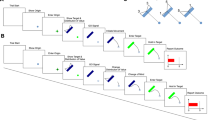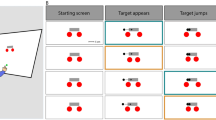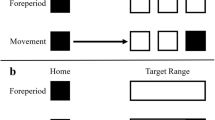Abstract
We examined how different characteristics of planned hand movements affect visual perception of distances in reachable space. Participants planned hand movements of certain amplitude. Before execution of the movement, certain visual distances had to be judged. Distances were judged as larger the larger the amplitude of the concurrently prepared hand movements was. On top of that, with constant movement amplitude, distances were judged as larger, the further away the start point of the planned movement was located from the body. These results indicate that distinct variables specified during motor planning, such as effector’s final position, are linked to the visual perception of environmental characteristics.






Similar content being viewed by others
Notes
Manipulating movement start position when movement amplitude is prescribed is essentially equivalent to manipulating the required end position. Yet, we prefer to describe this manipulation as one of start position, because this position is under full experimental control, whereas movement end positions depend on the way these movements are eventually carried out, and are thus less rigorously controlled.
Note, the lack of a significant effect of factor distance does not indicate that participants could not discriminate between the given target distances because the reported analyses were based on deviations of estimated magnitude from the real distance. When the magnitude of distance estimates was considered a distance effect was evident, F(3, 60) = 183. In our previous study (Kirsch and Kunde in press) we observed distance effects also in perceptual errors indicating an increase of an optical illusion with an increase in distance. In the present study, this effect was not observed probably due to a much smaller target range (11 vs. 41 mm).
References
Battaglia-Mayer A, Caminiti R, Lacquaniti F, Zago M (2003) Multiple levels of representation of reaching in the parieto-frontal network. Cereb Cortex 13:1009–1022
Bekkering H, Neggers SFW (2002) Visual search is modulated by action intentions. Psychol Sci 13(4):370–374
Berti A, Frassinetti F (2000) When far space becomes near: remapping of space by tool use. J Cogn Neurosci 12(3):415–420
Bhalla M, Proffitt DR (1999) Visual-motor recalibration in geographical slant perception. J Exp Psychol Hum Percept Perform 25(4):1076–1096
Bock O, Eckmiller R (1986) Goal-directed arm movements in absence of visual guidance: evidence for amplitude rather than position control. Exp Brain Res 62:451–458
Collins T, Schicke T, Röder B (2008) Action goal selection and motor planning can be dissociated by tool use. Cognition 109:363–371
Farnè A, Làdavas E (2000) Dynamic size-change of hand peripersonal space following toll use. NeuroReport 11(8):1645–1649
Gordon J, Ghilardi MF, Ghez C (1994) Accuracy of planar reaching movements: I. Independence of direction and extent variability. Exp Brain Res 99(1):97–111
Gutteling TP, Kenemans JL, Neggers SFW (2011) Grasping preparation enhances orientation change detection. PLoS ONE 6(3):e17675. doi:10.1371/journal.pone.0017675
Heuer H (1981) Fast aiming movements with the left and right arm: evidence for two-process theories of motor control. Psychol Res 43:81–96
Heuer H (2002) The effects of weak perturbations on rapid finger oscillations. Hum Mov Sci 21:119–130
Heuer H (2006) Multiple frames of reference for bimanual co-ordination. Exp Brain Res 175:485–498
Heuer H, Klein W (2006) Intermanual interactions related to movement amplitudes and endpoint locations. J Mot Behav 38(2):126–138
Heuer H, Sangals J (1998) Task-dependent mixtures of coordinate systems in visuomotor transformations. Exp Brain Res 119:224–236
Kirsch W, Kunde W (in press) Visual near space is scaled to parameters of current action plans. J Exp Psychol Hum Percept Perform. doi:10.1037/a0031074
Kirsch W, Herbort O, Butz MV, Kunde W (2012) Influence of motor planning on distance perception within the peripersonal space. PLoS ONE 7(4):e34880. doi:10.1371/journal.pone.0034880
Lee Y, Lee S, Carello C, Turvey MT (2012) An archer’s perceived form scales the “hitableness” of archery targets. J Exp Psychol Hum Percept Perform 38(5):1125–1131
Linkenauger SA, Witt JK, Stefanucci JK, Bakdash JZ, Proffitt DR (2009) The effects of handedness and reachability on perceived distance. J Exp Psychol Hum Percept Perform 35(6):1649–1660
Longo MR, Lourenco SF (2006) On the nature of near space: effects of tool use and the transition to far space. Neuropsychologia 44:977–981
Lourenco SF, Longo MR (2009) The plasticity of near space: evidence for contraction. Cognition 112:451–456
Polit A, Bizzi E (1979) Characteristics of motor programs underlying arm movements in monkeys. J Neurophysiol 42(1):183–194
Proffitt DR (2008) An action specific approach to spatial perception. In: Klatzky RL, MacWhinney B, Behrmann M (eds) Embodiment, ego-space, and action. Psychology Press, New York
Proffitt DR, Linkenauger SA (2013) Perception viewed as a phenotypic expression. In: Prinz W (ed) Action science, MIT Press, Cambridge
Proffitt DR, Stefanucci J, Banton T, Epstein W (2003) The role of effort in perceiving distance. Psychol Sci 14(2):106–112
Rosenbaum DA, Meulenbroek RJ, Vaughan J (1999) Remembered positions: stored locations or stored postures? Exp Brain Res 124(4):503–512
Sanders AF (1980) Stage analysis of reaction processes. In: Stelmach GE, Requin J (eds) Tutorials in motor behavior. North Holland, Amsterdam, pp 331–354
Schmidt RA, Sherwood DE, Walter CB (1988) Rapid movements with reversals in direction. I. The control of movement time. Exp Brain Res 69:344–354
Vishton PM, Stephens NJ, Nelson LA, Morra SE, Brunick KL, Stevens JA (2007) Planning to reach for an object changes how the reacher perceives it. Psychol Sci 18:713–719
Walsh WD, Russell DG, Imanaka K, James B (1979) Memory for constrained and preselected movement location and distance: effect of starting position and length. J Mot Behav 11:201–214
Witt JK (2011) Tool use influences perceived shape and perceived parallelism, which serve as indirect measure of perceived distance. J Exp Psychol Hum Percept Perform. doi:10.1037/a0021933
Witt JK, Dorsch TE (2009) Kicking to bigger uprights: field goal kicking performance influences perceived size. Perception 38(9):1328–1340
Witt JK, Proffitt DR (2008) Action-specific influences on distance perception: a role for motor simulation. J Exp Psychol Hum Percept Perform 34(6):1479–1492
Witt JK, Proffitt DR, Epstein W (2004) Perceiving distance: a role of effort and intend. Perception 33:577–590
Witt JK, Proffitt DR, Epstein W (2005) Tool use affects perceived distance but only when you intend to use it. J Exp Psychol Hum Percept Perform 31(5):880–888
Witt JK, Linkenauger SA, Bakdash JZ, Proffitt DR (2008) Putting to a bigger hole: golf performance relates to perceived size. Psychon Bull Rev 15(3):581–585
Witt JK, Proffitt DR, Epstein W (2010) When and how are spatial perceptions scaled? J Exp Psychol Hum Percept Perform 36(5):1153–1160
Acknowledgments
This research was supported by grant KI 1620/1-1 awarded to W. Kirsch by the German Research Council (DFG).
Author information
Authors and Affiliations
Corresponding author
Rights and permissions
About this article
Cite this article
Kirsch, W., Kunde, W. Moving further moves things further away in visual perception: position-based movement planning affects distance judgments. Exp Brain Res 226, 431–440 (2013). https://doi.org/10.1007/s00221-013-3455-y
Received:
Accepted:
Published:
Issue Date:
DOI: https://doi.org/10.1007/s00221-013-3455-y




